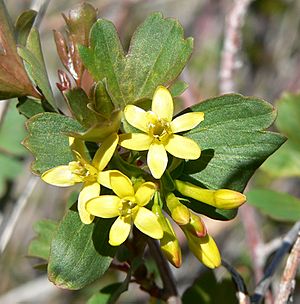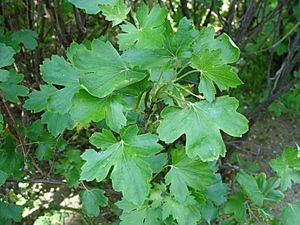Golden currant facts for kids
Quick facts for kids Golden currant |
|
|---|---|
 |
|
| Ribes aureum var. aureum, Spring Mountains, Nevada. | |
| Scientific classification | |
| Genus: |
Ribes
|
| Species: |
aureum
|
| Synonyms | |
|
List
Chrysobotrya aurea (Pursh) Rydb.
Chrysobotrya intermedia Spach Chrysobotrya lindleyana Spach Chrysobotrya odorata (H.L.Wendl.) Rydb. Chrysobotrya revoluta Spach Coreosma longiflora Lunell Coreosma odorata (H.L.Wendl.) Nieuwl. Ribes aureum var. longiflorum (Nutt.) Jancz. Ribes aureum var. tenuiflorum (Lindl.) Jeps. Ribes flavum Berland. Ribes fragrans Lodd. Ribes longiflorum Nutt. Ribes odoratum H.L.Wendl. Ribes odoratum var. intermedium (Spach) Rehder ex A. Berger Ribes palmatum Deshmukh Ribes tenuiflorum Lindl. |
|
The Golden Currant (scientific name: Ribes aureum) is a type of flowering plant. People also call it the clove currant or buffalo currant. It grows naturally in Canada, most of the United States (except the southeast), and northern Mexico.
This plant belongs to the Ribes group, which includes other currants like blackcurrants and redcurrants. It is the only plant in its special section called Symphocalyx.
Contents
What is the Golden Currant?
The Golden Currant is a small to medium-sized deciduous shrub. This means it's a bush that loses its leaves every autumn. It usually grows about 2 to 3 meters (6.5 to 10 feet) tall.
Leaves and Flowers
The leaves are green and have 3 or 5 lobes, which means they are divided into sections. In the autumn, these leaves turn a beautiful red color.
In spring, the plant blooms with bright golden yellow flowers. These flowers often have a strong, spicy smell, a bit like cloves or vanilla. Sometimes, the flowers can also be cream-colored or reddish. They grow in clusters of up to 15 flowers.
Fruits and Edibility
The Golden Currant bush starts making berries when it's quite young. These berries are about 1 centimeter (0.4 inches) wide. When they are ripe, they can be amber yellow or black.
You can eat the ripe berries, but they are very tart if eaten raw. Most people cook them with sugar to make them taste better. The flowers of the plant are also safe to eat!
Where Does the Golden Currant Grow?
The Golden Currant has a few different types, or varieties, that grow in specific places:
- Ribes aureum var. aureum: Found in the western U.S., usually below 900 meters (3,000 feet) in elevation.
- Ribes aureum var. gracillimum: Grows in the California Coast Ranges, also below 900 meters (3,000 feet).
- Ribes aureum var. villosum (also called clove currant): This type is native to areas west of the Mississippi River. It has also spread and now grows naturally further east.
How People Use Golden Currants
Golden Currants are useful plants for many reasons.
Growing Golden Currants
Many people grow the Golden Currant as an ornamental plant in their gardens. It's popular in traditional gardens, native plant gardens, and wildlife gardens. It's also great for xeriscaping, which is gardening that uses plants needing very little water. This plant is known for being very drought-tolerant.
Even though each flower has both male and female parts (hermaphroditic), the plant produces many more berries if different plants help each other with cross-pollination. This means pollen from one plant helps another plant make fruit.
Food and Medicine Uses
The berries are edible, but as mentioned, they can be bitter if not cooked.
Long ago, different Native American groups used the berries for food. They also used other parts of the plant for traditional medicine across North America.
Plant Health: Diseases
The Golden Currant can be affected by a fungus called white pine blister rust. This fungus can attack and kill pine trees. Because of this, sometimes Golden Currant bushes are removed from areas where the fungus is active. This helps stop the fungus from spreading to pine forests.
Types of Golden Currant Plants (Cultivars)
Plant breeders have created special types of Golden Currant plants called cultivars. These cultivars have unique features like bigger berries or better taste.
- Crandall: This is the oldest known type. It has large black berries, about 2 cm (0.8 inches) big. They have a spicy and nice smell. These berries ripen later in the season, becoming soft when ready. This type can pollinate itself.
- Idaho: Similar to Crandall, but it grows more strongly and produces more berries.
- Gwens: This type has berries shaped like teardrops. They ripen at different times, so you might see berries of many colors on the bush at once.
- Venus: This plant can handle dry weather and resists pests well. It produces a lot of berries, about 8 kg (17.6 lbs) per bush. The berries are 2-3 grams (0.07-0.1 oz), black, and very juicy. They ripen early and all at once.
- Lyaysan: Its berries are small (1-2 grams or 0.03-0.07 oz) but taste very good. They are golden-amber in color. The plant grows strongly but stays compact. It ripens in the middle of the season.
- Shafak: This type resists diseases and frost. Its fruits are 1.5 to 3 grams (0.05-0.1 oz), dark red, and teardrop-shaped. They ripen in the middle of the season.
- Zarina: This is a top-quality type bred in Russia. It comes from Venus and Lyaysan. Its berries weigh about 2.5 grams (0.09 oz) and have a sweet, excellent taste. They ripen mid-season and are golden-orange. It produces many berries.
- Uzbek: This type has very large black berries, up to 7 grams (0.25 oz). It produces a lot of fruit and is very tough.
- Seedless: This type has black fruit with golden insides. The fruit is sweet and juicy, weighing about 1.5-2 grams (0.05-0.07 oz). The bushes are compact and produce a high yield of 7–8 kg (15.4-17.6 lbs).
- Fatima: Along with Zarina, this is considered one of the best-tasting types, and it produces even more berries. Its black berries ripen early in the season.
- Seedless Raspberry: This plant spreads out and grows strongly. It produces a huge amount of berries, up to 12 kg (26.5 lbs) per bush. The berries are dark red and can weigh up to 4 grams (0.14 oz).


